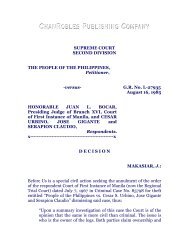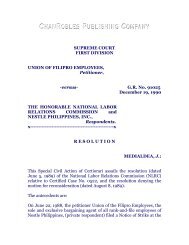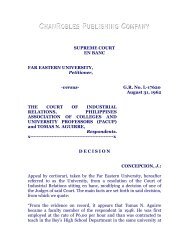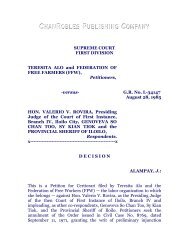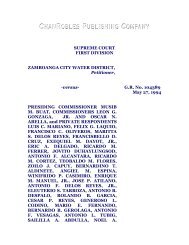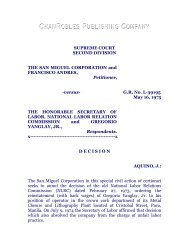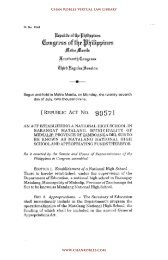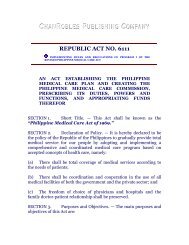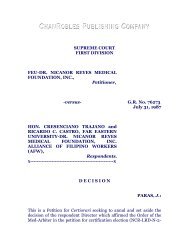ncmb manual of procedures for conciliation and preventive ...
ncmb manual of procedures for conciliation and preventive ...
ncmb manual of procedures for conciliation and preventive ...
Create successful ePaper yourself
Turn your PDF publications into a flip-book with our unique Google optimized e-Paper software.
attainment <strong>of</strong> industrial peace <strong>and</strong> prosperity, productivity <strong>and</strong>national development.RULE IIIDefinition <strong>of</strong> TermsSECTION 1.Definition <strong>of</strong> Terms1. Bureau <strong>of</strong> Labor Relations — BLR, <strong>for</strong> short, refers to theagency in the Department <strong>of</strong> Labor <strong>and</strong> Employment which h<strong>and</strong>lesappealed cases from decisions <strong>of</strong> Med-Arbiters on intra-uniondisputes. It is also the agency which h<strong>and</strong>les the processing <strong>and</strong>registration <strong>of</strong> national union <strong>and</strong> federations.2. Collective Bargaining Agreement — the negotiated contractbetween a duly certified or recognized exclusive bargaining agent <strong>of</strong>rank <strong>and</strong> file or supervisory employees <strong>and</strong> the employer concerningwages, hours <strong>of</strong> work <strong>and</strong> all other terms <strong>and</strong> conditions <strong>of</strong>employment in a bargaining unit, including m<strong>and</strong>atory provisions <strong>for</strong>grievance <strong>and</strong> arbitration machineries.3. Conciliation Case — refers to actual existing labor disputesubject <strong>of</strong> a notice <strong>of</strong> strike or lockout <strong>and</strong> cases <strong>of</strong> actual strike orlockout.4. Conciliator-Mediator — <strong>of</strong>ficial <strong>of</strong> the NCMB whose principalfunction is to settle <strong>and</strong> dispose potential <strong>and</strong> actual labor disputesthrough <strong>conciliation</strong> <strong>and</strong> <strong>preventive</strong> mediation including thepromotion <strong>and</strong> encouragement <strong>of</strong> voluntary approaches to labordisputes prevention <strong>and</strong> settlement.5. Deputy Executive Director — refers to the <strong>of</strong>ficial who assiststhe Executive Director <strong>of</strong> the NCMB in per<strong>for</strong>ming the functions <strong>of</strong>the Board. chanroblespublishingcompany6. Executive Director — refers to the heard <strong>of</strong> the NationalConciliation <strong>and</strong> Mediation Board.7. Grievance Procedures — refer to the internal rules <strong>of</strong><strong>procedures</strong> established by the parties in their collective bargaining
agreement with voluntary arbitration as the terminal step, which areintended to resolve all issued arising from the implementation <strong>and</strong>interpretation <strong>of</strong> their collective agreement.8. Intra-Union Disputes — refer to cases involving the control,supervision <strong>and</strong> management <strong>of</strong> the internal affairs <strong>of</strong> a dulyregistered labor union such as those relating to specific violations <strong>of</strong>the union's constitution <strong>and</strong> by-laws. chanroblespublishingcompany9. Inter-Union Disputes/Representation Disputes — refer to casesinvolving petition <strong>for</strong> certification election <strong>and</strong> direct certificationfiled by a duly registered labor organization which is seeking to berecognized as the sole <strong>and</strong> exclusive bargaining agent <strong>of</strong> the rank <strong>and</strong>file employees in the appropriate bargaining unit <strong>of</strong> company, firm orestablishment.10. Labor <strong>and</strong> Employment Officer — LEO, <strong>for</strong> short, as used in thisManual, refers to an <strong>of</strong>ficial <strong>of</strong> the NCMB who assists directly orindirectly the Conciliator/Mediator <strong>and</strong> other NCMB <strong>of</strong>ficials in theper<strong>for</strong>mance <strong>of</strong> their <strong>of</strong>ficial functions.11. Labor or Industrial Dispute — includes any controversy ormatter concerning terms or conditions <strong>of</strong> employment or theassociation or representation <strong>of</strong> persons in negotiating the fixing,maintaining, changing or arranging the terms <strong>and</strong> conditions <strong>of</strong>employment, regardless <strong>of</strong> whether or not the disputants st<strong>and</strong>s inthe proximate relationship <strong>of</strong> employer <strong>and</strong> employee. chanroblespublishingcompany12. Labor St<strong>and</strong>ards laws — refer to the minimum terms <strong>and</strong>conditions <strong>of</strong> employment set by law under Book III <strong>of</strong> the LaborCode <strong>of</strong> the Philippines, as amended.13. Labor Union — is an organization <strong>of</strong> employees in a company,firm or establishment, duly registered with the Department <strong>of</strong> Labor<strong>and</strong> Employment.14. Lockout — refers to the temporary refusal <strong>of</strong> an employer t<strong>of</strong>urnish work as a result <strong>of</strong> an industrial or labor dispute.
15. National Conciliation <strong>and</strong> Mediation Board — or NCMB, <strong>for</strong>short, refers to the agency attached to the Department <strong>of</strong> Labor <strong>and</strong>Employment principally in-charge <strong>of</strong> the settlement <strong>of</strong> labor disputesthrough <strong>conciliation</strong>, mediation <strong>and</strong> <strong>of</strong> the promotion <strong>of</strong> voluntaryapproaches to labor dispute prevention <strong>and</strong> settlement.16. National Labor Relations Commission — NLRC, <strong>for</strong> short,refers to the agency attached to the Department <strong>of</strong> Labor <strong>and</strong>Employment in-charge <strong>of</strong> deciding labor cases through compulsoryarbitration.17. Notice <strong>of</strong> Lockout — refers to the notification filed by anemployer with the appropriate NCMB regional branches in<strong>for</strong>mingthe latter <strong>of</strong> its intention to temporarily cease its operation because <strong>of</strong>alleged commission by a duly registered labor union <strong>of</strong> unfair laborpractice acts or because <strong>of</strong> a deadlock in collective bargainingnegotiations.18. Notice <strong>of</strong> Strike — refers to the notification filed by a dulyregistered labor union with the appropriate NCMB regional branchesin<strong>for</strong>ming the latter <strong>of</strong> its intention to go on strike because <strong>of</strong> allegedcommission by the employer <strong>of</strong> unfair labor practice act/s or because<strong>of</strong> a deadlock in collective bargaining negotiations.19. Picketing — is the right <strong>of</strong> workers to peacefully march to <strong>and</strong>fro be<strong>for</strong>e an establishment involved in a labor dispute generallyaccompanied by the carrying <strong>and</strong> display <strong>of</strong> signs, placards <strong>and</strong>banners intended to in<strong>for</strong>m the public about the dispute.20. Preventive Mediation Cases — refer to the potential labordisputes which are the subject <strong>of</strong> a <strong>for</strong>mal or in<strong>for</strong>mal request <strong>for</strong><strong>conciliation</strong> <strong>and</strong> mediation assistance sought by either or both partiesor upon the initiative <strong>of</strong> the NCMB to avoid the occurrence <strong>of</strong> actuallabor disputes.21. Regional Director — refers to the head <strong>of</strong> the Regional Office <strong>of</strong>the Department <strong>of</strong> Labor <strong>and</strong> Employment.21. Director II — refers to the head <strong>of</strong> a Regional Branch <strong>of</strong> theNational Conciliation <strong>and</strong> Mediation Board.
23. Executive Labor Arbiter — ELA, <strong>for</strong> short, refers to the head <strong>of</strong> aRegional Branch <strong>of</strong> the National Labor Relations Commission.24. Strike — refers to any temporary stoppage <strong>of</strong> work in anestablishment by the concerted action <strong>of</strong> its employee as a result <strong>of</strong> anindustrial or labor dispute. chanroblespublishingcompany25. Strike Area — means the establishment, warehouses, depots,plants or <strong>of</strong>fice, including the sites or premises used as run-awayshops <strong>of</strong> the employer struck against, as well as the immediatevicinity actually used by picketing strikers in moving to <strong>and</strong> fro be<strong>for</strong>eall points <strong>of</strong> entrance to an exit from said establishment.26. Unfair Labor Practice Acts — ULP, <strong>for</strong> short, are those actscommitted either by employers or labor organizations as enumeratedunder Articles 248 <strong>and</strong> 249 <strong>of</strong> the Labor Code, as amended.27. Voluntary Arbitrator — any person accredited by the Board assuch, or any person named or designated in the collective bargainingagreement by the parties to act as their voluntary arbitrator, or onechosen, with or without the assistance <strong>of</strong> the National Conciliation<strong>and</strong> Mediation Board, pursuant to a selection procedure agreed uponin the collective bargaining agreement, or any <strong>of</strong>ficial that may beauthorized by the Secretary <strong>of</strong> Labor <strong>and</strong> Employment to actvoluntary arbitrator upon the written request <strong>and</strong> agreement <strong>of</strong> theparties to a labor dispute.28. Deputized Hearing Officer — any NCMB <strong>of</strong>ficial deputized orassigned by the Secretary <strong>of</strong> Labor <strong>and</strong> Employment to conducthearings, received position papers <strong>and</strong> evidence from the parties on alabor dispute assumed by the Secretary pursuant to Article 263(g) <strong>of</strong>the Labor Code, as amended. chanroblespublishingcompany29. Supervision — it means the participation <strong>of</strong> the regional branch<strong>of</strong> the Board in the secret balloting process participated in by the totalunion members in the bargaining unit concerned to declare a strike inorder to determine the majority vote. (Sec. 44. Rule XIII, Rules <strong>and</strong>Regulations Implementing R.A., No. 6715).
to settle the dispute as early as possible because the union may takeimmediate action after the strike vote. The Conciliator or hisauthorized representative may supervise the conduct <strong>of</strong> the strikevote <strong>and</strong> receive the result there<strong>of</strong>.The determination as to whether the alleged violation/s <strong>of</strong> theeconomic provisions <strong>of</strong> the CBA are flagrant <strong>and</strong>/or malicious isbasically lodged in another <strong>for</strong>um. This notwithst<strong>and</strong>ing, theConciliator shall proceed to extend <strong>conciliation</strong>/mediation services tothe parties or counsel the parties to use other voluntary modes <strong>of</strong>dispute settlement such as voluntary arbitration or <strong>preventive</strong>mediation.SECTION 3. Action on Non-Strikeable Issues. — A strike orlockout notice anchored on ground involving 1.) inter-union <strong>and</strong>intra-union disputes, or 2.) on issues already brought to voluntary orcompulsory arbitration, or 3.) mere violation <strong>of</strong> the collectivebargaining agreement involving political provisions may beconsidered not duly filed <strong>and</strong> the party so filing may be notified <strong>of</strong>such finding either orally or in writing by the Director II. On his part,the Conciliator shall convince the party concerned to voluntarilywithdraw the notice without prejudice to further <strong>conciliation</strong>proceeding. Otherwise, he shall recommend to the Director II that thenotice be treated as a <strong>preventive</strong> mediation case.When the issue/s involve the violation <strong>of</strong> the labor st<strong>and</strong>ard laws, <strong>and</strong>the parties opt not to continue with the <strong>conciliation</strong>, the Conciliator,through the Director II, shall immediately refer the case to theconcerned Regional Director.On issues involving questions <strong>of</strong> representation, the Conciliator shallascertain whether there is a petition <strong>for</strong> certification election, ordirect certification, involving the parties which may be pending eitherbe<strong>for</strong>e the Med-Arbiter at the Regional Office or on appeal with theOffice <strong>of</strong> the Secretary. If such case is indeed pending, the Conciliator,through the Director II, shall promptly advise the RegionalDirector/Office <strong>of</strong> the Secretary <strong>of</strong> the existence <strong>of</strong> the notice <strong>of</strong> striketo enable them to act on the case at the earliest time possible. TheConciliator shall exert best ef<strong>for</strong>ts to monitor <strong>and</strong> report to hisDirector II the development/progress <strong>of</strong> the case.
If, after verifying that no such case is pending, the Conciliator is fullyconvinced that the petitioning union is duly registered with theDepartment <strong>of</strong> Labor <strong>and</strong> Employment, he shall exert diligent ef<strong>for</strong>tsto enable the parties to settle the issue through voluntary recognitionor consent election. If settlement is reached, the Conciliator, throughthe Director II, shall immediately furnish the concerned RegionalDirector a copy <strong>of</strong> the agreement <strong>for</strong> the latter's guidance <strong>and</strong>appropriate action. If no consent was given, he shall advise the partyconcerned to file the necessary petition with the appropriate body.SECTION 4. Notice Converted to Preventive Mediation. — Whena notice <strong>of</strong> strike or lockout has been converted into a <strong>preventive</strong>mediation case, the following guidelines must be followed:1. Clearly determine whether the issue/s raised in the notice <strong>of</strong>strike is/are strikeable or not.2. If conversion is warranted, a written recommendation from theConciliator-Mediator h<strong>and</strong>ling the case is required, after a closeconsultation with the Regional Branch Director.3. The written recommendation must be <strong>for</strong>mally endorsed to theRegional Branch Director II <strong>for</strong> approval.4. The conversion must be done be<strong>for</strong>e the cooling-<strong>of</strong>f periodexpires or be<strong>for</strong>e the union conducts its strike balloting. chanroblespublishingcompany5. Parties concerned must be <strong>for</strong>mally notified <strong>of</strong> the action takenby the Regional Branch through a letter signed by the Conciliator-Mediator h<strong>and</strong>ling the case <strong>and</strong> approval by the Director II.6. The notice shall be dropped from the docket <strong>of</strong> notices <strong>of</strong>strike/lockouts <strong>and</strong> to be renumbered as a <strong>preventive</strong> mediation case<strong>and</strong> a conference is set on a specific date/s.However, in cases where unresolved grievances are raised in notices<strong>of</strong> strikes <strong>and</strong> lockouts being h<strong>and</strong>led by Conciliator-Mediators or incomplaints filed be<strong>for</strong>e Labor Arbiters, said unresolved grievancesshould immediately be referred to the Voluntary Arbitrator mutually
accepted by the parties from the list <strong>of</strong> NCMB Accredited VoluntaryArbitrators <strong>for</strong> appropriate action.SECTION 5. Identification <strong>of</strong> Issues. — The Conciliator assignedto a notice <strong>of</strong> strike shall, during the initial joint or separate meeting,properly identify <strong>and</strong> specify the real issues raised in the notice.When the notice carries several charges <strong>of</strong> unfair labor practice, itshall be the duty <strong>of</strong> the Conciliator to clarify with the parties thespecific acts <strong>of</strong> unfair labor practice which were alleged to have beencommitted. chanroblespublishingcompanySECTION 6. Action on Notices Involving Issue/s Cognizable byGrievance Machinery, Voluntary Arbitration or the National LaborRelations Commission.a) When it appears that the issues raised in the notice are propersubjects <strong>of</strong> the grievance machinery, hence, not strikeable, theConciliator, after a reasonable number <strong>of</strong> conferences shall, throughthe Director II, refer the resolution <strong>of</strong> the issues to the grievancemachinery, including the use <strong>of</strong> voluntary arbitration as provided <strong>for</strong>in the CBA, <strong>and</strong> as matter <strong>of</strong> policy under Department Order No. 7,Series <strong>of</strong> 1987, dated May 7, 1987.b) Disputes arising from questions <strong>of</strong> interpretation orimplementation <strong>of</strong> the Agreement <strong>and</strong> company personnel policiesshall be referred to the grievance machinery as provided <strong>for</strong> underR.A. by the Conciliator assigned to h<strong>and</strong>le the dispute.c) Disputes arising from the wage distortion resulting from thewage order issued by the Regional Wage <strong>and</strong> Productivity Board shallbe referred to the appropriate regional branch <strong>of</strong> the NLRC if notsettled within ten (10) calendar days <strong>of</strong> <strong>conciliation</strong>. chanroblespublishingcompanyd) In case the parties agreed to suspend the running <strong>of</strong> thecooling-<strong>of</strong>f period, the Conciliator should convince them to limit theperiod <strong>of</strong> suspension to 45 calendar days after which it shall have theeffect <strong>of</strong> having been dropped from the business calendar <strong>of</strong> the<strong>of</strong>fice.
RULE VIReporting <strong>and</strong> Verification <strong>of</strong> Actual Strike or LockoutSECTION 1. Verification <strong>of</strong> Actual Strike or Lockout. — TheConciliator, in case <strong>of</strong> actual strike or lockout, shall verify whether ornot the requirements <strong>for</strong> valid strikes/lockouts have been compliedwith, to wit: chanroblespublishingcompany1. Whether the issues raised are valid grounds <strong>of</strong> notice <strong>of</strong>strike/lockout, i.e. bargaining deadlock, unfair labor practices <strong>and</strong>flagrant <strong>and</strong>/or malicious violations <strong>of</strong> the economic provisions <strong>of</strong> thecollective bargaining agreement.2. Whether the cooling-<strong>of</strong>f period was complied with, i.e. 15 days<strong>for</strong> unfair labor practice <strong>and</strong> 30 days <strong>for</strong> bargaining deadlock.3. Whether the majority-strike/lockout vote was validly compliedwith <strong>and</strong> the result there<strong>of</strong> reported to the Regional Branch <strong>of</strong> theBoard.SECTION 2. The results <strong>of</strong> the verification shall exclusively be <strong>for</strong>internal use only by the Board <strong>and</strong> shall have no the evidentiarypurpose whatsoever.RULE VIIStrike Vote <strong>and</strong> Improved/Reduced Offer BallotingSECTION 1. Strike or Lockout Vote. — A decision to declare astrike must be approved by a majority <strong>of</strong> the total union membershipin the bargaining unit concerned obtained by secret ballot in meetings<strong>of</strong> referenda called <strong>for</strong> the purpose. A decision to declare a lockoutmust be approved by a majority <strong>of</strong> the board <strong>of</strong> directors <strong>of</strong> theemployer corporation or association or the partners in a partnershipobtained in a meeting called <strong>for</strong> the purpose.SECTION 2. Initiative or Request. — The Regional Branch <strong>of</strong> theBoard may, at its own initiative or upon the request <strong>of</strong> any affectedparty, supervise the conduct <strong>of</strong> the secret balloting. All requests <strong>for</strong>the conduct <strong>of</strong> the strike balloting must be filed with the RegionalBranch <strong>of</strong> the Board at least 3 days be<strong>for</strong>e the date <strong>of</strong> voting. The
Conciliator concerned shall require the parties to furnish the regionalbranch <strong>of</strong> the Board the notice <strong>of</strong> meetings referred to in thepreceding paragraph at least three (3) days be<strong>for</strong>e such meetings aswell as the results <strong>of</strong> the voting at least seven (7) days be<strong>for</strong>e theintended strike or lockout, subject to the cooling-<strong>of</strong>f period.SECTION 3. Improved Offer. — When at least a majority <strong>of</strong> theunion members vote to accept the improved <strong>of</strong>fer, the strikingworkers shall be notified by the Conciliator so that they canimmediately return to work <strong>and</strong> <strong>for</strong> the employer to readmit themupon the signing <strong>of</strong> the agreement. chanroblespublishingcompanySECTION 4. Reduced Offer. — In case <strong>of</strong> a lockout, the Boardshall also conduct a referendum by secret ballot on the reduced <strong>of</strong>fer<strong>of</strong> the union on or be<strong>for</strong>e the 30th day <strong>of</strong> the lockout. When at least amajority <strong>of</strong> the board <strong>of</strong> directors or trustees or the partners holdingthe controlling interest in the case <strong>of</strong> a partnership, vote to accept thereduced <strong>of</strong>fer, the workers shall immediately return to work <strong>and</strong> theemployer shall thereupon readmit them upon the signing <strong>of</strong> theagreement.SECTION 5. Nature <strong>of</strong> Mechanics. — In all instances, theConciliator shall conduct a pre-conference be<strong>for</strong>e the secret ballotingto thresh out the mechanics <strong>and</strong> to impress upon the parties thatstrike vote/or improved <strong>of</strong>fer balloting is not in the nature <strong>of</strong>certification election wherein the usual legal <strong>procedures</strong> shall beapplied. chanroblespublishingcompanyRULE VIIIFinal AgreementSECTION 1. Preparation <strong>of</strong> the Agreement. — Extra care must betaken in drafting the Agreement in order to minimize doubtful orvague interpretation that might result to further disagreement orworsening <strong>of</strong> the problem. The Conciliator must see to it that theagreement must be clear <strong>and</strong> concise <strong>and</strong> must contain all points <strong>of</strong>the parties' underst<strong>and</strong>ing. chanroblespublishingcompanySECTION 2. Implementation <strong>and</strong> Compliance. — The conclusion<strong>of</strong> an agreement does not per se terminate the responsibility <strong>of</strong> the
Conciliator over the case. He must monitor the implementation <strong>and</strong>compliance therewith to ensure that the parties have indeednormalized their relationship.RULE IXReporting RequirementsSECTION 1. Submission <strong>of</strong> Reports. — All Conciliators mustregularly submit the necessary progress reports to the NCMB CentralOffice through the Directors II <strong>for</strong> cases <strong>of</strong> labor st<strong>and</strong>ard laws orwage distortions, copy furnished the Regional Director or ExecutiveLabor Arbiter concerned, utilizing, the <strong>for</strong>m prescribed <strong>for</strong> thepurpose (Form 02 [see Annex 2]). The Final Conciliator's Report shallbe submitted to the Office <strong>of</strong> the NCMB Executive Director IVutilizing the outline prescribed by the Board (Form 03 [see Annex 3]).January 31, 1992chanroblespublishingcompany(SGD.) BUENAVENTURA C. MAGSALINExecutive Director IV


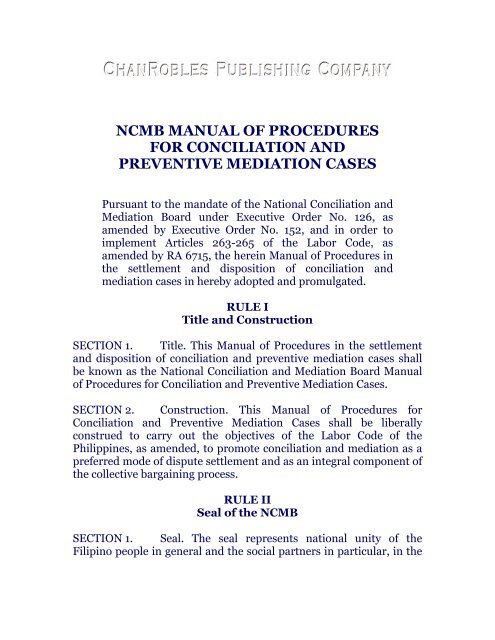
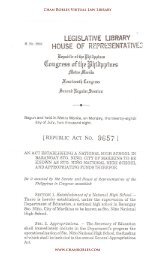
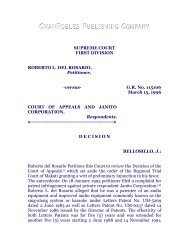
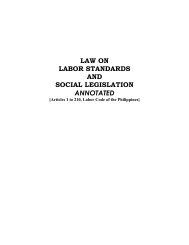
![Aurelio vs. NLRC, (221 SCRA 432 [1993]) - Chan Robles and ...](https://img.yumpu.com/51280528/1/190x245/aurelio-vs-nlrc-221-scra-432-1993-chan-robles-and-.jpg?quality=85)
